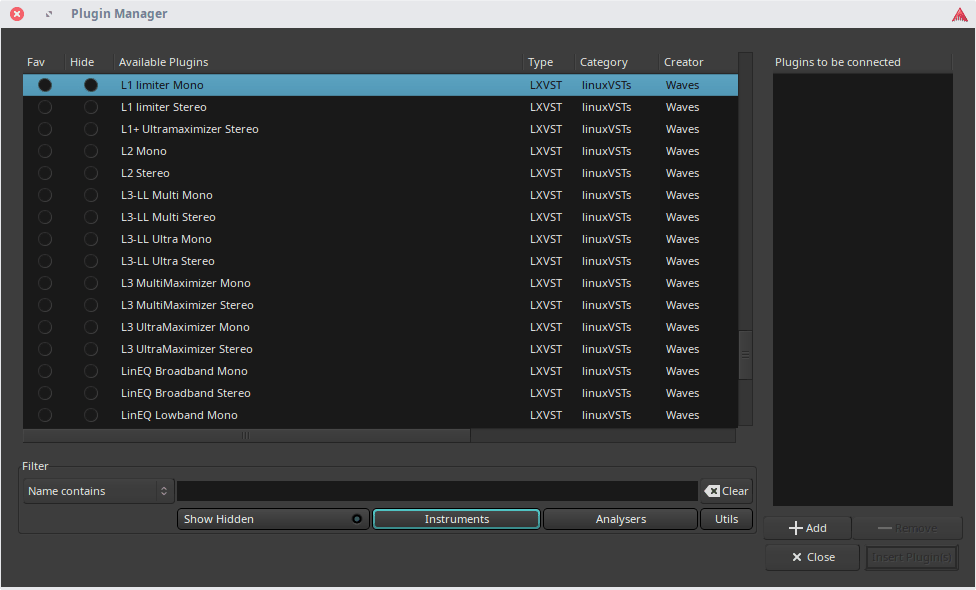Ardour Linux Vst Plugins
This is a tutorial on how to add, install and use plugins in Ardour using Linux. Plugins are highly valuable anytime you do audio mixing and mastering work. Example of plugins can be reverb, EQ, compressors, etc.

Linux Audio Plugins
Also, for your vst plugins, you still can use them under linux using dssi-vst, a standalone host that will run them outside Ardour (you can use creating inserts on ardour tracks). The advantage of this is that if a vst plugin crashes or fails Ardour will not crash. Also, try out Calf and Invada LV2 plugins, they are really good. Daw & Audio Editor • Linux » Ardour 5.0 x86 x64 WIN. Steinberg – Cubase 7.5 Plugins Bundle VST x86.
Install Ardour first
- The best Free Music Software Freeware, VST, VSTi, Plugins Download.
- Ardour comes with a handful of builtin plugins for your everyday needs. Thousands of other plugins, both free, proprietary and for-cost, are available to download and install on your system from dozens of plugin makers. 3 major plugin formats supported: AudioUnits (OS X), VST (Windows & Linux.
- Using Plugins with Ardour. Ardour does not come with any built-in signal processors of its own. However, there are hundreds of plugins (effects and instruments) that you can use with Ardour, many of which are available at no charge.
This is tested to work in Ubuntu Lucid Lynx and Ardour 2.8.6. If you still have not installed Ardour, then follow the steps below:
1.) First, make sure your Ubuntu distribution is updated. In Ubuntu, go to System – Administration – Update manager, make sure it says “Your system is up to date”.
2.) Install “jackd” first, these are low latency audio tools very useful for recording. Go to System—Administration–Synaptic Package Manager. In the newly released distribution of Linux, it does not anymore include Synaptic Manager. But there should be a tool for managing installed software. For example in Ubuntu, this is called Ubuntu Software manager.
Login using your root Linux password. Under quick search, type jackd
3.) Check “jackd” and then click “mark for installation” , there are other dependent packages to be installed so just click “Mark” as well. To install these packages, click “Apply” in the Synaptic package manager menu. If it ask “Apply the following changes”? Click Apply.
4.) If it ask enable jackd for realtime process priority? Check yes and click “Forward”. After installation it will be marked with green marks beside them. Make sure jackd, jackd-firewire, and qjackctl are green marks.
In the modern installation of Ardour particularly with the latest Ubuntu distributions, it will automatically configure for real time implementation of Jack. You simply need to press “Forward” to install. Most expensive plugins vst for pro tolls 12.
But you can always confirm by going to Places—Computer—File System–etc–security–limits.d. Make sure there is a file there called “audio.conf” with the contents below:
@audio – rtprio 99
@audio – memlock unlimited
#@audio – nice -19
5.) You need to confirm that you have added your username to the @audio group. Go to System—Administration—Click “Manage Groups”. Click “audio” group under “Group settings”, then click “Properties”. Under “Group members”, check your Ubuntu username and click OK. Verify by entering your root Linux password. Then close all windows.
6.) Logout to your username and login again (not restart or reboot just click Logout).
7.) After logging back in, Go to Applications – Ubuntu Software – and in the search box , type “Ardour”. When you see “Ardour GTK2”, click “Install” then proceed by entering your Linux password to authenticate.
Ardour in Ubuntu software
Best Professional Vst Plugins
8.) Try starting Jack first before starting Ardour. It is because Ardour depends on JACK. Enter the command in the terminal: qjackctl. For details, read this tutorial:

And then go to Step 4.c. There is a procedure there on how to start Jack without Xruns.
9.) After installation, launch Ardour by going to Applications –Sound and Video– Ardour GTK2.
10.) Finally click “Start”. You are then ask to start a new session. Select “new session” tab.Type the name of the sesssion example, “sessiontest” . Then for convenience I saved the files to my Ubuntu desktop. Click “New”.
11.) The nice-looking Ardour digital audio workstation environment will then load up, ready to accept tracks for you to record, mix or even master.